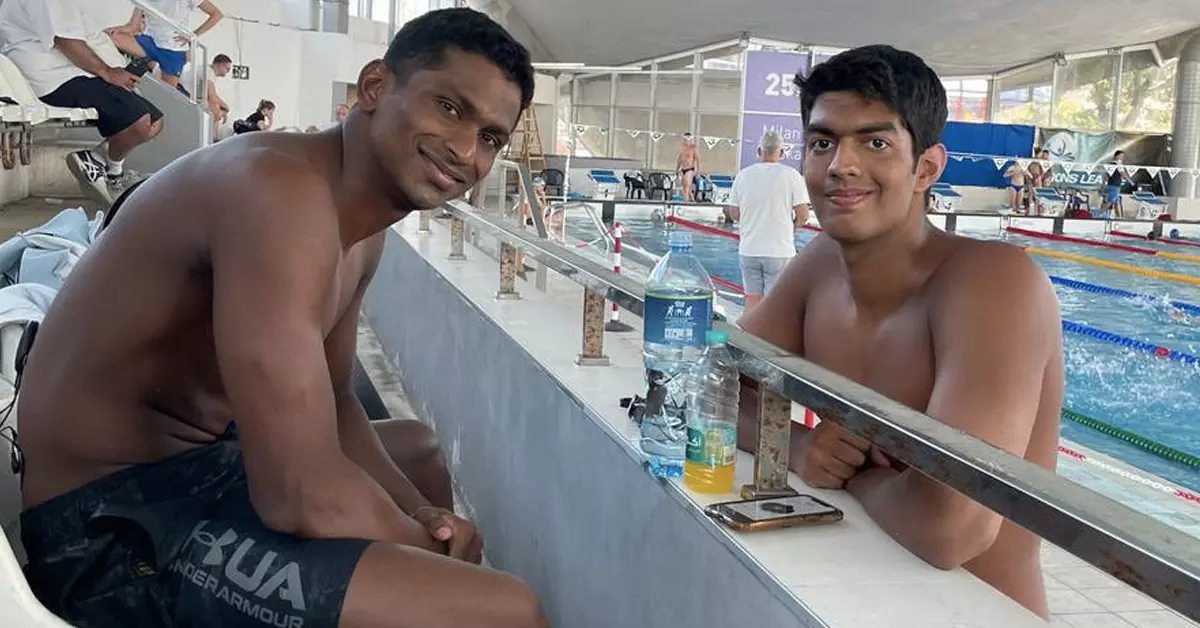Swimming
The Olympics 'A' qualification is a new start for Indian swimming believes former Olympian Shikha Tandon
India's former Olympian swimmer Shikha Tandon believes the newly achieved 'A' cut for Olympics will bring more youngsters into swimming who have examples ahead of them

Indian swimmers Sajan Prakash and Srihari Nataraj (Source: Swimming Federation of India)
Swimming occupies one of the prime spots in the Olympics — a sport that has witnessed vast popularity among spectators since time immemorial. Despite having the second-highest number of Olympic events in swimming, India's success in the pool has been limited, where none has ever moved beyond the preliminary rounds at the Olympics. The Tokyo Olympics will nevertheless be special for two Indian swimmers who created history by breaching the 'A' qualification mark for the first time.
In each of the Olympic Games in 2012 and 2016, India had sent swimmers based on universality invitational. However, Sajan Prakash and Srihari Nataraj managed to make significant breakthroughs - attaining the unthinkable.
Prakash became the first Indian swimmer ever to register an Olympic 'A' cut when he swam men's 200m butterfly event in 1:56.38 at the Sette Colli Trophy in Italy. The FINA 'A" standard in the event is 1:56.48. The next day, Srihari Nataraj became the second Indian swimmer to hit the FINA "A" cut when he swam a 53.77 in the 100m backstroke at the same meet in Rome. The men's 100m backstroke 'A' standard is 53.85. Both Prakash's and Nataraj's times from the Sette Colli Trophy would have earned a spot in the semifinals at the 2019 World Championships.
While the country had two men under the "A" standard, they relied on the Universality program for Maana Patel's qualification as the only woman on the team. With a total of three entries, India will have the largest Olympic swimming contingent since 2008, when four had qualified.
The three has definitely heralded a new dawn for the sport, which can be vouched for by the stalwarts of the Indian swimming fraternity. The Bridge spoke to former Indian swimmer Shikha Tandon, who represented India at the 2004 Athens Olympics at just the age of 19.
"It is definitely a big moment for Indian swimming because if you look back over the last, 20-24 years, all the swimmers that have gone for the Olympics, including me, could manage only the B qualifying mark. An 'A' cut was something that we've all been chasing through our careers and the fact that it's finally happened not just with one swimmer but with two, is something huge for India. It's a new start. I think it will bring a lot of youngsters into the sport who will not only just go for the Olympics with a 'B' time but now have examples in front of them that 'A' cut is attainable. When something happens for the first time, it is a huge milestone, and that's really what this is. Hopefully, we're going to have some of the girls also vying for this time and maybe in the next Olympics, we can have them join the record as well," says Tandon.
Looking beyond the success the three swimmers have courted inside pools, what is even more fascinating is their journey, reaping on a single-minded focus towards the Tokyo Games.
Pakash, who made his Olympics debut in Rio 2016, had clocked a timing of 1:59:3s — three seconds slower than his best time ahead of Tokyo Games. One should mull over this three-second difference and understand how significantly Prakash has improved in a sport where a nano-second of difference can crush medal dreams. The Keralite attained the major leap even after he was laid low by a career-threatening neck injury in July 2019 and, of course, the COVID-19 induced lockdown followed by, which wreaked havoc particularly upon swimmers.
Prakash first observed the signs of neck injury during the sidelines of the World Championships in Gwangju in July 2019. The truth hit him hard when during the Nepal South Asian Games in December, scans revealed a slipped disc on his neck's C4, C5, and C6 bones. It followed months of rehab, and his recovery was hit hard by the lockdown as he could not get into the pool after shifting to Thailand. Even managing to stroke his arm confidently for the tricky butterfly form was a challenge. But he put deaf ears to all restrictions and attained his poetic justice of breaching the 'A' mark.
At many stages in the past couple of months, Nataraj might have had the thought that his chance to directly qualifying for the Olympics had ended. The 20-year-old, who achieved the 'B' qualification mark winning the gold in Uzbekistan in April with a timing of 54.07s, fell short by an agonising 0.22 seconds. He weaponised the sheer perseverance that led him to fetch a satisfactory result home. Srihari's qualification was pushed to the last moment as he found himself in slower heats after the time that he set at the controversy-ridden Uzbekistan Open event was declared null and void when the meet was stripped of its status as an Olympic qualifier recently. He even missed the Olympic qualifying mark by 0.05s at the Sette Colli Trophy in Rome initially but two days later, he redeemed himself. A 20-year-old who trains in the pool like a madman, it speaks volume about his dedication to not settle for less. As he trained, his timings improve, he grew in confidence and mentally ready too.
Consistency has been the elixir for 21-year-old Patel, who has been India's finest woman swimmer for some time now. A swimmer with the Olympic Gold Quest since 2015, Patel bagged three gold medals at 72nd Senior National Aquatic Championships in 2018. At the Senior Nationals in Thiruvananthapuram in 2018, she clinched all three backstroke events. However, she had sustained an ankle injury in 2019 and only made a comeback earlier this year, recuperating through the lockdown phase. She competed in Uzbekistan Open Swimming Championships in April, her first event of the year, where she clocked 1:04.47 seconds for the gold medal in the 100m backstroke. In also took part in events in Serbia and Italy to warm up for the Tokyo Games, where she went on to better her national mark in the 100m backstroke.
Tandon adds, "Each of the three swimmers qualified this time for Tokyo Olympics, have had such unique individual journeys to share. Srihari is a youngster who has been simply improving. Every meter he swims, he's been improving. Sajan is coming back from a pretty serious injury. The past couple of years have been very tough for him. Maana had also her share of ups and down but she broke her national record and peaked right on time, which exudes great hope. Given the fact, that all of them had succeeded despite the long lockdown is inspiring."
Swimming has never been India's forte at the Olympic Games. It took a further Step back when the coronavirus had hit hard. It also happens to be among the last sports to have opened for training after the lockdown. Six months after they were sent out, swimmers returned to the pool only on October 15 last year. India sent three elite swimmers — Nataraj, Kushagra Rawat, and Prakash — to Dubai towards the end of August for a two-month training camp organised by the Swimming Federation of India. Indian swimming at the top level appears now to have a youthful and promising look about it. "I think a lot things have gone well for Indian swimming in the last five years. Simple things like just access to better pools, access to better coaching, access to funds to not only compete and buy your equipment but also to go out and compete have improved. Big swimming brands like Speedo for example, have come into India over the last few years and now sponsoring athletes today. We barely enjoyed such facilities at our times. The Swimming Federation of India (SFI) has actively taken part in improving the sport, and many of the former athletes and swimmers coming back into the sport in various roles have over the years helped the country," says Tandon. She adds, "To have more youngsters join the sport, more youngsters continue the sport and then more talented swimmers be supported through their careers and their journeys ... and that's when we're going to see the real impact at the Olympics. Not just qualifying, but then making the semifinal or the final and then finally winning that when the Olympic medal."
Even being one most popular sports in the world, competitive swimming remains somewhere restricted to a few pockets in India, and the number of coaches remains limited. "We need more good coaches in India that can bring out the best in a swimmer at the international level. We already are seeing the result of having good coaches, but we shouldn't stop here. More coaches and further knowledge sharing across the states of the country will be the key in the future. Swimming is evolving every single day, it's a very technical sport, so India needs to have coaches at the top of the developments happening all over the world."
Tandon, a former athlete from Bengaluru is now based in San Francisco and is the Director of Global Partnerships at SVEXA (Silicon Valley Exercise Analytics), which is an exercise intelligence and sports analytics company, provides data to athletes and coaches to optimise performance. She has closely followed the developments in the frontiers of US Swimming and, therefore, through her experience, shares, "In the US and places where there is a structured swim program, it starts right from the middle school and then goes on in high schools and colleges. These institutions play a big role in promoting the sport, like swimming. If India can replicate something like that, then athletes not having to necessarily make a choice between swimming or study; they will have the opportunity to do both. I think in places like the US and Australia, where swimming is pretty prevalent, that's one of the things that really stands out is just the ability to train and compete for something like the Olympics at your own college, which can imitate."
"I really expect to see our swimmers in the semifinals of the Tokyo Olympics," concludes Tandon.
Swimming doesn't enjoy a fandom in India as it has in wrestling and shooting, but the Indian swimmers will be entering the Tokyo Olympics to etch a historic feat that could be cherished by the entire nation.

